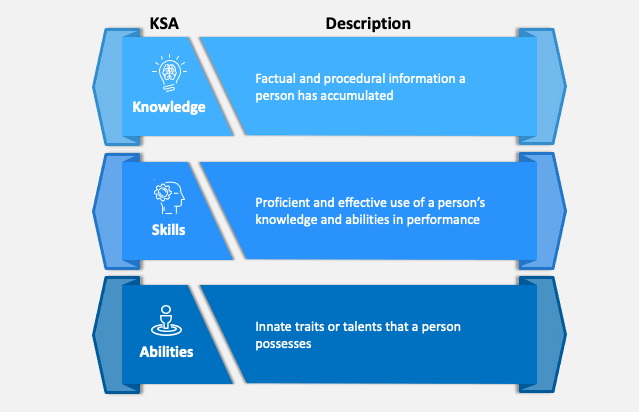As businesses expand and develop, their workforce requirements shift. New positions are formed. Current roles change to incorporate new technology. Employees may leave or switch roles. Performing a job analysis helps employers, employees, and applicants have a clear understanding of job roles. This can greatly enhance efficiency, boost job satisfaction, and aid in attracting top talent. These five steps will guide human resources professionals in carrying out an effective job analysis that brings significant value to their organizations.
What Is Job Analysis?
A job analysis is the process of assessing a specific job role to determine the duties and requirements of the role as well as how that role fits within the organization. It includes:
- Tasks performed as part of the job
- Objectives and how the role adds value to the business
- Skills, knowledge, attitudes, and other characteristics required to perform the job successfully
- The context in which the job is performed i.e. working environment and relationships
Note: A job analysis is not an assessment of the individual who holds that role but of the role itself.
Who Does a Job Analysis?
A job analysis is usually conducted by a human resources professional, such as a trained job analyst, or an external consultant. However, small businesses without such professionals can also make great use of a job analysis.
When Is a Job Analysis Conducted?
A job analysis typically occurs at the start of a recruitment process, before strategic workforce planning, or when employee roles are changing a lot, like during a restructuring. If it has been some time since the last job analysis, you may want to carry out a regular job analysis to enhance everyday human resource management tasks, such as performance reviews.
Benefits of a Job Analysis
Job analyses can lead to a range of improvements in human resource management. The main benefits fall into five categories.
1. Better Recruitment Processes
Job applicants want to know exactly what a specific job entails and what kind of candidate is likely to succeed. Fair compensation is also a top priority for job seekers. A thorough job analysis will help you craft a clear and detailed job description and set appropriate compensation so you can attract applications from top talent.
A thorough understanding of job characteristics makes it easier to select the right person for the position – and avoid the costly process of replacing an inappropriate hire later on. This is a win for both businesses and job candidates.
An objective set of hiring criteria also helps to limit subjectivity and bias and gives your business legal defensibility if there is a dispute about the fairness of your hiring process.
2. Workforce Efficiency
Creating clear job descriptions for your organization can boost efficiency because it helps you:
- hire and promote the most suitable candidates
- design effective onboarding procedures
- allocate tasks to employees with the required skills and training
- ensure employees are chasing the right goals
- hold employees accountable for their responsibilities
- design effective incentive structures
- meet training needs
- provide the appropriate tools and work environment
- identify structural workforce issues e.g. the same task allocated to two teams
3. Employee Satisfaction
According to polling data, job unhappiness is at an all-time high. This impacts a business’s bottom line as unhappy workers are often less productive and more likely to resign. A job analysis can improve employee satisfaction by ensuring:
- New hires are suited to their jobs
- Jobs match expectations established during recruitment
- Employees have clear, specific goals
- Promotions and incentives are based on transparent, impartial objectives
- Employees are competitively compensated
- A suitable work environment is provided
4. Labor Relations
A job analysis can be used to develop objective performance criteria for a job. If performance appraisals are based on these criteria, an organization is better protected against disputes with employees who feel they have been unfairly overlooked for career advancement or incentives. Similarly, these criteria can be used to justify terminating an employee’s contract.
5. Health and Safety
An added benefit of the job analysis process is that it gives HR professionals an insight into the working conditions of their employees. This creates an opportunity to identify any health and safety hazards or other kinds of issues that need to be addressed.
What Are the Outputs?
A job analysis is primarily used to write or update a job description, like the one below.
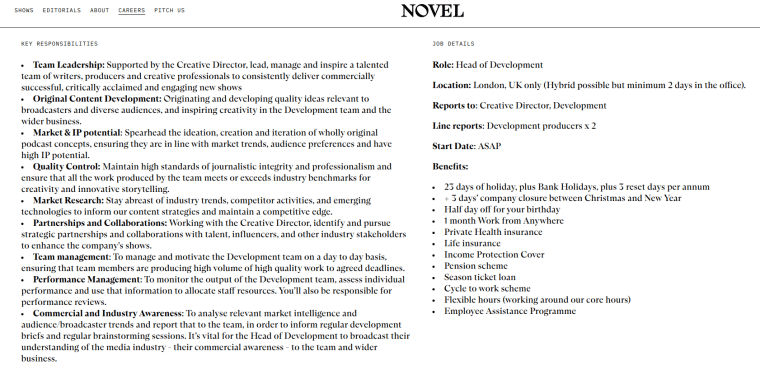
It can also be used to update or prepare:
- onboarding materials
- performance management plans
- incentive policies
- reports to senior management
How to Perform a Job Analysis in Five Simple Steps
A job analysis is essentially a process of gathering and applying data. Depending on your goals, it can be a simple, informal process that takes an afternoon or a complex, resource-intensive process that lasts months. Here are the five essential steps of a typical job analysis.
1. Plan Your Process
Before you conduct a job analysis, identify the primary goal and the output you need to produce. This will influence how you go about conducting the analysis. Your goal may be to write a job description for a new role in order to recruit for a growing team or to assess a department ahead of a strategic workforce planning session.
Take note of the time, money, and resources available to conduct the job analysis, and identify all the stakeholders. Based on this information, decide on a job analysis method (more on that below). Write out a plan and schedule for the job analysis.
2. Gather Internal Data
Your goal and time frame will determine the exact data you need but job analysis data usually includes the specific tasks that make up the job, objectives, the required knowledge, skills, and abilities, the resumes of employees who hold the position, the social and mental demands of the job, relationships that are important to the job, the working environment, and the tools and software used on the job.
If you are analyzing an existing role in your organization, you can gather job analysis data from the employee who holds that position. There are several ways to do this.
- Observation: Watching the employee perform the job is a method best suited to jobs that involve physical processes e.g. surgeon or mechanic.
- Interviews: A formal or informal conversation with the employee helps you gain a better understanding of their role. This method is suited to most roles.
- Questionnaire: The advantage of a questionnaire is that it generates a written record and can be conducted asynchronously. You can design your own questionnaire or use a Position Analysis Questionnaire (PAQ) – a standardized job analysis questionnaire suitable for any job or industry. You can see examples here and here.
- Survey: If you have multiple staff members who do the same job, you can use a survey to collect and compare data from the whole group e.g. call center workers
- Work diary/log: Asking employees to keep a log of everything they do throughout the day is a good way to assess the duration and frequency of different tasks. This method generates useful insights into jobs that involve a variety of tasks.
- Work sample: If the job requires the production of outputs (anything from funding proposals to pastries) you can request a sample to gain a deeper understanding of the job requirements.
- Test: You can set a test for the employee in order to establish a benchmark level of knowledge and skills. This is helpful for jobs that require a base level of knowledge from day one e.g. mathematics teacher, software developer, or air traffic controller. You could also set a personality test.
In addition to engaging with the employee, you can gather data using:
- Internal documents: Training manuals, performance reviews, and onboarding documents are all packed with useful information.
- Job performance: The job analyst can perform the job for a temporary period to experience first-hand the specific activities, work context, and demands of the role.
- Managers and colleagues: Speaking to other people in the organization can reveal what makes someone succeed in the position, how it fits into the team, and how it has evolved over time.
- Competitor job descriptions: Your competitors are likely hiring for similar positions so you may be able to gain valuable insights about the position from their job descriptions and materials. Be careful, however, as your business’ needs will almost certainly be at least somewhat unique.
3. Conduct Industry Research
In order to stay competitive, companies need to offer salaries that match or exceed what other employers are offering for similar jobs (or provide other incentives). Researching what other companies pay employees in similar positions can help you decide how much to pay your own employees. Industry research will also help you understand the skill level and experience expected. Here are some useful resources.
- Job boards. Search for the job title on job boards like LinkedIn and Indeed and study the job descriptions that come up. This is especially effective in a quick, low-resource job analysis.
- O*NET. Occupational Information Network (O*NET) is the US Department of Labor’s job database and it includes hundreds of standardized job descriptions and other data. Here is a portion of their job analysis on physical therapists.
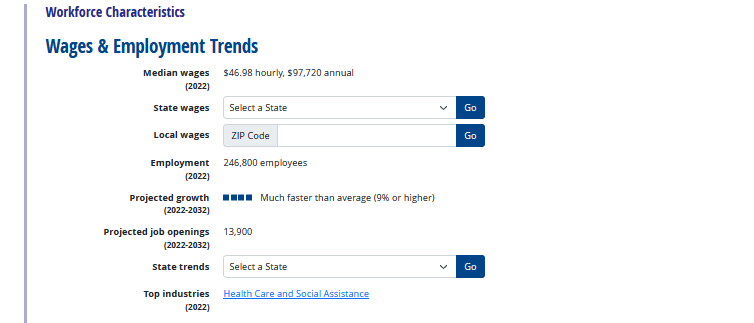
- Compensation data sources. Sites like Payscale.com, Salary.com, and the US Bureau of Labor Statistics website provide compensation data.
- Professional guidelines. For some professions, there are guidelines that tell you if a candidate should have passed certain exams, hold a license, or be registered with a professional organization.
- Your network. If you reach out to other employers or subject matter experts, they may share insights that will add nuance to your job analysis.
4. Analyze the Data
Once you have finished collecting data, the next step in the job analysis is to make sense of the data you’ve gathered. You can divide it into the following areas:
Tasks
List the tasks associated with the job as well the percentage of the employee’s time spent on each task.
KSAs
List the knowledge, skills, and abilities (also known as KSAs) required for the role. Consider the minimum proficiency required for a new recruit. Ask how these KSAs might be represented on a resume as experience or education. Separate the essential elements from the desirable ones.
Compensation
Compare the compensation you plan to offer for the position to the going rate across the industry. Consider whether it matches the difficulty level of the position and the value the role adds to the business. Compare the compensation for the position to that of different jobs in your organization.
Finally, if you have an existing job description, identify any discrepancies between your data and the original description to see how the role has changed.
5. Apply Your Findings
Return to the goal you set in step one of your job analysis and use your new insights to create your output. Revise the job description to improve its accuracy, resolve omissions, and incorporate changes to the role. Update related documents e.g. manuals.
If you’ve discovered any structural problems (e.g. duties that would be better suited to another role or department) channel that information to the right people. Keep a record of the data you’ve gathered.
Job Analysis Methods
Most job analyses will use the steps that we’ve already covered but HR experts have developed lots of job analysis methods over the years, each with their own focus and philosophy that can make the process a breeze. Here are some of the most popular methods.
Task Inventory Method
This job analysis method focuses only on the tasks performed as part of a job. Use the data-gathering techniques outlined above to make a list of every task performed as part of the job as well as time spent on each specific task. If you were gathering this data using a questionnaire, it might look something like this:
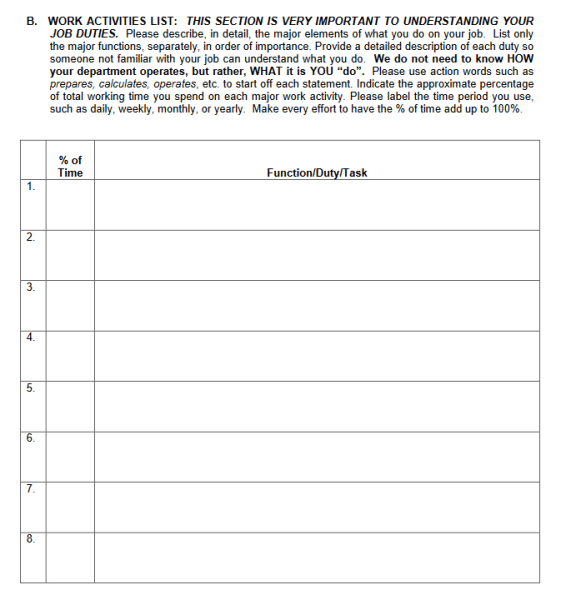
You can break tasks down into smaller units as follows. This is called a task analysis.
Job: Marketing executive
This job can divided into approximately five duties.
Duty: Manage company social media accounts
This duty can be divided into three or four tasks.
Task: Manage Instagram account
Activities:
- Plan content schedule
- Research Instagram trends
- Take and edit photos and videos
- Write copy
- Publish posts
- Respond to comments and messages
- Track followers and engagement
Once you have a task inventory, you can organize tasks into categories (e.g. management or creative tasks) and detail the frequency, importance, and difficulty of each task, as in this example.
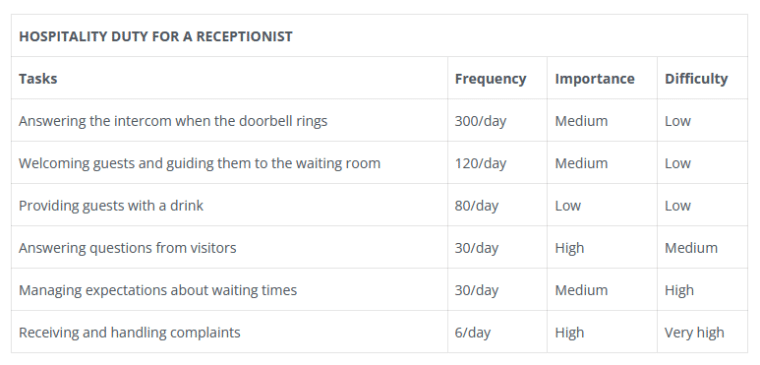
The task inventory method of job analysis is straightforward and gives you a thorough understanding of the day-to-day content of a role but it leaves out critical aspects like objectives, competencies, and skills required, as well as intangible elements of the job like strategy, creativity, and decision making. It is useful to combine this job analysis method with other job analysis techniques.
Critical Incident Technique (CIT)
The Critical Incident Technique is a job analysis method that examines how an employee behaves in relation to particular events or critical incidents. Here are the three main steps that make up a CIT job analysis.
- Identify incidents that have taken place in the course of the employee’s work that led to an outstanding or unacceptable result e.g. salesperson makes a record sale or an account manager loses a major client.
- Gather information from the employee and others involved to understand how the employee behaved and the impact of the incident on the organization.
- Use the data to identify the qualities and behaviors that led to success or failure.
CIT takes into account events that might otherwise be ignored and highlights behaviors that have a major impact on the business. However, it ignores the day-to-day activities that make up a role.
Even if you choose not to adopt the full CIT for your job analysis, it may still be useful to take an incident-focused approach when asking employees questions. For example, “Tell me about a time when you placated an angry customer” might elicit more valuable details than, “How do you deal with angry customers?”.
Functional Job Analysis (FJA)
Functional Job Analysis is a job analysis methodology developed by Sidney Fine and his colleagues and outlined in their 1971 book ‘An Introduction to Functional Job Analysis’. The method includes a number of formalized procedures for organizing and analyzing data. Let’s take a look at some of them.
Formulating a task statement
According to Fine’s book, you can use five questions to craft a task statement that contains all the important information about a task.
- Who? This is the worker e.g. doctor’s receptionist.
- Performs what action? This should be an action verb e.g. ‘asks’.
- To accomplish what result? Identify a clear objective e.g. to record basic information about a new patient.
- With what tools, equipment, or work aids? e.g. intake form
- Upon what instructions? Detail any instructions or briefs that prompt the worker to perform the task e.g. new patient calls to register
Things, Data, People
In an FJA, tasks can be divided into three orientations.
- Tasks where a worker engages with things e.g. operating a machine
- Tasks where a worker engages with data e.g. creating a graph from a spreadsheet
- Tasks where a worker engages with people e.g. supervising trainees
Tasks with multiple orientations should be broken down as follows.
Task statement: Asks client questions, listens to responses, and adds answers to digital database…in order to record basic identifying information about patients.

These systems help to provide structure and objectivity in the job analysis process but the techniques are quite rigid and dated. It also requires a lot of knowledge and time to implement this method.
Strong Job Analysis Examples
Let’s take a look at two hypothetical examples of effective job analyses.
Santa Claus
Santa slips on some ice and injures his back. The Chief Elf conducts a job analysis in order to recruit a temporary Santa while he recovers. He conducts the following interview with Santa.
- What is the main purpose of your job?
To spread joy and incentivize children to be good. - Talk me through your major duties in order of importance. Use action words to tell me what you do. Tell me what percentage of your time they take up.
I manage the Naughty and Nice List. This takes up 80% of my time outside of the Christmas period. I add, remove, and move children according to their age and behavior. I spend 15% of my time overseeing the toy workshop. I observe the workshop and meet with my managers to make decisions. I spend 5% of my time training with my reindeer. On Christmas Eve I spend 100% of my night delivering gifts. - What knowledge, skills, and attributes are required for your role?A strong moral compass, data management, management experience, manufacturing experience, toy industry knowledge, sleigh driving, chimney climbing, and passion about Christmas.
- What training do you have?Advanced sleigh driving certificate.
- What are the physical requirements of your role?You need to be able to climb down chimneys.
- What are the work conditions?I live in the North Pole and work through the night on Christmas Eve.
- What are the mental demands?If you fail, you will disappoint millions of children.
- What are the important relationships in your role?You need a strong working relationship with the Chief Elf and also with the reindeer.
The Chief Elf uses all of this information to craft a job description which he posts on LinkedIn.
TripBookers Travel Agency
The objective: TripBookers travel agency has 300 travel consultants. The company is very good at selling holidays but customers have complained that, after they’ve booked a holiday, their customer service declines. The CEO asks the HR manager, Jo, to do a job analysis to identify any structural problems with the role that might be causing this problem.
The method: Jo uses work diaries to assess how much time consultants spend on sales vs service. She uses CIT to analyze major customer service successes and failures. Finally, she interviews TripBookers consultants and managers who have previously worked at other travel agencies to find out what they think about different job configurations e.g. separating sales and customer service into two jobs.
The findings: Jo learns from the work diaries that the consultants who sell the most holidays are the ones who do the least customer service. From the CIT, she determined that consultants who lacked empathy and training caused the worst customer service incidents. From the interviews, she learns that consultants avoid providing customer service because it does not generate commission.
The output: Jo writes a report for the CEO outlining two strategies. The first is to introduce incentives for good customer service and conduct more customer service training. The second is to identify consultants with the most empathy and give them a new job title – customer service consultant. She also updates the job description because traits like empathy were not previously listed.
Quick Tips for a Successful Job Analysis
- Customize your process to meet your organization’s needs.
- Get buy-in from key stakeholders, like managers.
- Adapt roles regularly to keep up with changing industries and new technology.
- Apply copywriting principles to avoid dry, full job descriptions.
Don’t Underestimate the Power of Job Analysis
A job is the basic building block of an organization. Each building block should be clearly defined with a set position in the larger structure. If you can master key job analysis techniques, you will build a solid foundation for your workforce and set yourself up to meet crucial objectives across recruitment, retention, productivity, and risk management. In short, assessing and defining jobs helps you do yours better.
